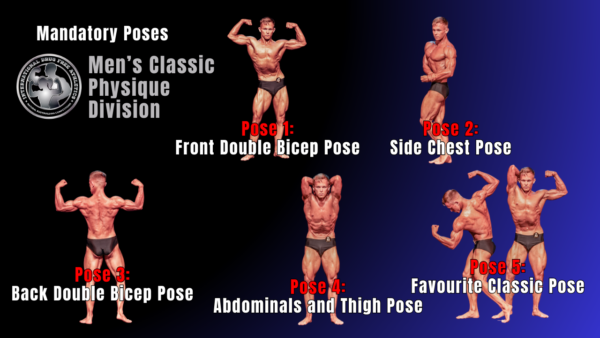This detailed breakdown of the Classic Physique Division within the IDFA outlines everything an athlete needs to know before stepping on stage. Whether you’re a novice or a seasoned pro, understanding these guidelines is crucial for success in competition.
Is Classic Physique for You?
 You aspire to embody the timeless aesthetic of the golden era of bodybuilding, aiming to showcase a physique that is both muscular and refined, with a strong emphasis on symmetry and proportion. Your goal is to create a seamless flow between each muscle group, resulting in a harmonious and visually stunning appearance.
You aspire to embody the timeless aesthetic of the golden era of bodybuilding, aiming to showcase a physique that is both muscular and refined, with a strong emphasis on symmetry and proportion. Your goal is to create a seamless flow between each muscle group, resulting in a harmonious and visually stunning appearance.
Beyond your physical attributes, you radiate confidence and dominate the stage with undeniable presence. Posing becomes your art form, where you highlight your physique’s strengths with fluidity and precision.
You step on stage with a routine that captivates both the audience and judges, showcasing your unique style and charisma.
Have questions or need more information? We’re here to help. Contact Shaun or join our Free Facebook group, IDFA Room, to connect with fellow competitors and get inspired.
Athlete Attire: What do you Wear?
Posing Suit:
- Competitors wear plain black spandex shorts (no branding or logos are permitted, bodybuilding posing trunks are prohibited).
- Classic physique shorts should adequately cover the center portion of glutes from top to bottom, more specifically, we should not see the glutes touching.
- Must be in good taste and approved by the IDFA prior to competition.
- Worn during both the Judging round and Presentation & Awards round.
- All suits will be checked at Athlete Registration/Check-in.
Jewellery:
- Only small earrings and wedding rings are permitted.
Classes: Where do you Fit?
Novice Classic Physique:
- Competitors who have not placed in the top 3 in an Open class equivalent in another organization or in the Novice class in an IDFA sanctioned event.
- If more than 10 competitors, there will be 2 classes divided evenly and fairly based on height.
Open Classic Physique:
- Competitors who have placed top 3 in the Novice class in an IDFA sanctioned event or in the Open class equivalent in another organization.
- If more than 10 competitors, there will be 2 classes divided evenly and fairly based on height.
- Winners of the Open class will earn IDFA Pro Status, provided there are at least 3 athletes in the class.
Masters 40+ Classic Physique:
- Competitor is at least 40 years of age on day of competition.
- One class for all Masters 40+ Classic Physique competitors.
Masters 50+ Classic Physique:
- Competitor is at least 50 years of age on day of competition.
- One class for all Masters 50+ Classic Physique competitors.
Pro Classic Physique:
- Competitors who hold a current IDFA Pro Card
- Competitor has earned Pro Status in a recognized natural organization and has been approved to compete in the IDFA Pro Division. The IDFA must approve this prior to competition.
- One class for all Pro Classic Physique competitors.
Crossovers: Competing in Multiple Classes & Divisions
- Masters 40+: Competitors in the Masters 40+ class can also enter the Novice and/or Open classes.
- Masters 50+: Competitors in the Masters 50+ class have the option to enter the Novice and/or Open classes. Additionally, they can also compete in the Masters 40+ class.
- Novice Competitors: Novice competitors may be allowed to enter the Open class as well, but this requires approval by the Promoter on a show-by-show basis.
- Multiple Divisions: Athletes are allowed to enter more than one Division in the same show. For example, you can compete in both Bikini and Fitness Model, or in Men’s Bodybuilding and Men’s Classic Physique at the same event.
This flexibility allows you to showcase your physique across different divisions and classes, maximizing your competitive experience and opportunities to shine on stage.
Judging Criteria: How will you be Judged?
Judges will assess:
- Abdominal Separation: Judges will look for visible separation within the abdominal region, ensuring clarity from top to bottom.
- Muscle Group Definition: The physique should display clear definition between all three heads of the deltoids, triceps, and biceps. There should also be distinct lines between the quadriceps muscle groups and hamstrings, with full, shapely, and symmetrical muscle bellies.
- Balance and Symmetry: The physique should strike a balance between size and symmetry. It should not appear overly shredded, vascular, grainy, overly dense, or thick. Instead, the focus is on clear lines between all muscle groups without displaying cross-striated muscle groups as seen in traditional bodybuilding.
- Symmetry Priority: In judging, symmetry will take priority over size or extreme conditioning, making it the key factor in the evaluation of the physique.
This judging criteria emphasizes a balanced, aesthetic appearance, highlighting the art of physique over sheer muscle mass or extreme leanness.
Judging Round: What do you have to do on stage?
Competitors will:
- Line up in numerical order, facing the front in a relaxed pose.
- Execute a series of mandatory poses as directed by the Head Judge.
Mandatory Poses:
- Front Double Bicep Pose
- Side Chest Pose (choice of side)
- Back Double Bicep Pose
- Abdominals and Thigh Pose
- Favourite Classic Pose (not a most muscular pose)
Presentation & Awards Round: Amateur (Novice, Open, Masters)
- Competitors perform a Free Posing Round to background music, lasting 30 to 45 seconds, highlighting 4-6 poses.
Presentation & Awards Round: Pro
- Pro competitors perform a 60-second Posing Routine with music provided in advance (MP4 format preferred).
- No required mandatory poses. Competitors choose poses that best showcase their physique.
- Scoring mainly occurs during the Judging Round, but the Presentation Round may act as a tiebreaker.
- No props or costumes allowed.
Awards Presentation:
After the presentation round for each competitor in the class is completed:
- All competitors in the class will exit the stage behind the curtain. If there are 5 or fewer competitors in the class, they will remain on stage.
- The top 5 competitors will be called back to the stage, in no particular order, to the back line. Awards will be handed out to the top 5 on stage during the show. Note: Every athlete in the class will get an official placing on the IDFA website after the show.
- The awards presenter will place a medallion around your neck as you line up on the front line of the stage. Competitors will be arranged in order from 5th to 1st place. The top 5 placements will be officially announced on stage.
- After the awards are handed out, a photo will be taken of the Top 5, then the Top 3, and finally, a solo photo with the Winner.
- Note: For the Pro Classes we will Official place every one of them on the stage at the event. For example, if we have 8 Pro competitors, we will place them 8th to 1st place at the show with medallions.
Award Details:
- Amateur: The Top 3 will receive Large IDFA Custom Medallions, while 4th and 5th place will receive smaller IDFA medallions.
- Pro: The Top 10 will receive Large IDFA Custom Medallions. Cash prizes may be awarded, and these will be announced prior to the event.
This is the process for awarding competitors in all classes, ensuring a clear and organized presentation.
JUDGING – ONLINE COMPETITIONS
Submitted Competitor Photos and Videos will be compared against the Photos and Videos of the other competitors in your class. Official IDFA Judges will be individually and privately going over all of the competitor Photos and Videos and comparing them and ranking them from 1st place to the final placing and submitting them to the IDFA as their official placings just as we do at our Live Competitions. All competitors will be placed.
PHOTOS and VIDEO SUBMISSIONS – ONLINE COMPETITIONS
We will need a photo of each mandatory pose. We will also need a VIDEO of you performing all the mandatory poses.
For the Photos and Video make sure we see your entire body from the bottom of your foot to the top of your head. You can not edit or use filters on the Photos and Video. For the Video, if you are using your phone, hold it upright (or vertically). We will be putting together a Contest Coverage and Results video for every online competition.
To validate the date we will need one photo of you holding a piece of paper with the code word on it. We will be emailing the code word out to all the athletes late the evening before the online competition.
Send your Photos and Videos submissions to info@idfa.ca. We can also use sending files sites such as DropBox, Wetransfer, etc. If you prefer another method for sending Photos and Videos please email Shaun at info@idfa.ca. The main file sharing programs we use are Dropbox and WeTransfer.
If you have any questions please message Shaun at info@idfa.ca.
This comprehensive guide ensures that you’re fully prepared for every aspect of the competition, from attire to posing and judging criteria. Whether you’re just starting or aiming for the Pro division, this information will help you present your best self on stage.










